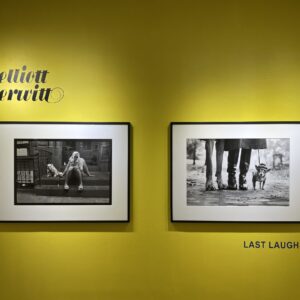JTF (just the facts): A total of 8 color photographs, framed in light wood and unmatted, and hung in the 3 connected rooms of the main gallery space. All of the works are chromogenic prints, made in 2014. Each is sized roughly 45×60 inches, and is available in an edition of 4. The show also includes a sculpture made of razor wire, rebar, and aggregate, from 2014. It is sized roughly 79x118x79 inches, and is unique. In addition, a poem “Afghanistan is the Home of Afghans” is displayed on a poster and read aloud in Pashto (in two sets of headphones), 1 minute 43 seconds in duration, and reproductions of 4 paintings are shown on ledges as postcards/book pages. A monograph of this body of work was published in 2015 by Here Press (here). Wirobound, 32 pages, with 8 color photographs, 4 paintings, and 3 Taliban poems. In an edition of 450 copies. (Installation shots below.)
Comments/Context: While many photographs of war tell the story of gritty battlefields and active engagements with the enemy, Edmund Clark’s images from his series The Mountains of Majeed document the war in Afghanistan from a more arm’s length perspective. Taken at the end of Operation Enduring Freedom from within the confines of Bagram Airfield – the largest American military base in Afghanistan – his images explore what the country looks like to the military personnel and contractors who never actually leave the protective confines of the base.
The conceptual core of the project lies in a series of murals painted inside various conference rooms and facilities at Bagram. Made by the artist “Majeed”, they depict an idealized, almost fairy tale view of Afghan life, from snow-covered mountains, idyllic lake reflections, and humble thatched cottages in steep valleys to camel caravans and Kabul landmarks surrounded by lush greenery. They are the simple paintings of an artist who wants to celebrate the romance of his homeland, where the ruggedness and beauty of nature are treated like points of national pride.
But Clark’s on-the-base photographs capture an alternate vantage point for those same landmarks of geography. From an inside-looking-out perspective, the mountains consistently linger in the far off distance, often shrouded by haze that makes them into a dusty smudge on the horizon. Each and every one of Clark’s images features these mountains as a backdrop, and so we begin to see that life in Bagram is a constant look outward at the enduring power of those mountains.
The foreground of Clark’s pictures is variously littered with the mundane and often ugly realities of man-made base life. Concrete blast walls are pieced together in sections, creating a secure perimeter topped with razor wire, and this barrier finds its way into most of Clark’s views. Nearest the wall, he finds textures: expanses of smooth, empty cement, craters of dirt and garbage carved out by earth movers, and piles of sand, rocks, and trash. Closer in, he shows us ordered arrays of tents (each kept cool by a sunny yellow air blower) and ambulance parking areas, the routines and patterns of base-life writ large.
Where Clark’s photograph succeeds is in their juxtapositions and in their surprising beauty. A massive American flag and a mural of a friendly soldier shaking hands with an Afghan boy provide upbeat symbols of the mission, but the grim pit of rotting garbage and the endless plastic bags caught in the razor wire bring that optimism back down a notch or two. His pictures document the structure of a bubble-like atmosphere, where one set of ideas is dominant inside the walls, and another (as evidenced by the passionately anti-foreigner Taliban poetry included in the show) wholly opposite mindset is rooted outside.
In the end, the mountaintops remain a constant force, and a squared off view of pavement, blast walls, mountains, and sky, all in shades of soft grey blue, finds the just right point of sublime Lewis Baltz-meets-21st-century-war strangeness. In one picture, Clark has captured both the confident technical excellence of the occupier and the slow indifferent resistance of the land and its peoples, showing us the strengths of both forces and the stubborn intractability that prevents any kind of easy resolution.
Collector’s POV: The prints in this show are priced in rising editions, starting at $6000. Clark’s work has little secondary market history at this point, so gallery retail likely remains the best option for those collectors interested in following up.

















In 2008 Broomberg and Chanarin took a more absurdist approach to photographing in occupied Afghanistan, with, ‘The Day Nobody Died’. For a long time I thought it was a massive wasted opportunity, but nowadays think it’s probably the only piece made there that means anything much.
http://www.broombergchanarin.com/the-day-nobody-died-1-1/
But, if you want something really intriguing, there’s the tank film ‘The Beast’ (1988′)(aka ‘The Beast of War’), set during the Soviet occupation, and which now reads entirely differently, of course.